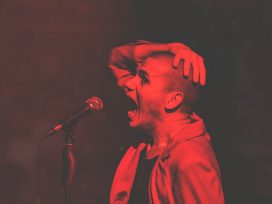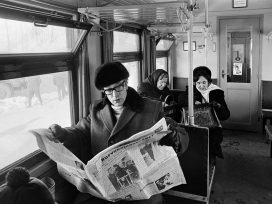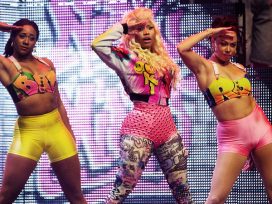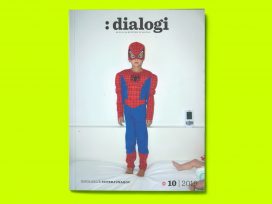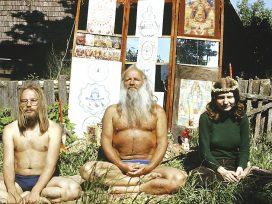“Laibach” is German for the Slovenian capital Ljubljana, and the city’s original name, dating back to 1144. However most Slovenians today connect the name to the year 1943, when the Nazis occupied the city and brutally subjugated its population to the fascist ideological apparatus of the Third Reich.
The Slovenian state’s political and historical self-awareness had been based on notions of socialist progressiveness, national independence, and the fight against fascism. Therefore, that a group from the youth culture of the early 1980s (shortly after the death of Tito) should choose to step into the public arena bearing the name “Laibach” was highly problematic. The name has a strong but ambivalent politicising symbolism. Laibach developed this in their theatrical punk-rock concerts, in which the lead singer posed as Mussolini, and in media appearances, in which the band dressed in military uniform and robotically read aloud from their manifesto. This led to a long and multifaceted controversy resulting in the group being officially banned from performing in Slovenia under their own name from 1983 to 1987. Instead, they chose to tour both sides of the Iron Curtain – their “Occupied Europe Tour” – and co-founded the collective Neue Slowenische Kunst, a state (with its own diplomatic passport) defined not by geographic territory but by the intellect’s power of abstraction.
But what meaning should one read in the name in relation to Laibach’s greater scheme? That they have for more than 25 years, and in similar ways, problematised other instances of power (including those beyond the Slovenian context), for example Nato, the rock concert, Western democracy, the pop industry, and most recently, the national anthem? Is their use of arm-bands, flags, hunting horns and projections of war scenes an expression of neo-fascist aesthetics? Or an ironic critique of the very same? It is difficult to decide because the name is symptomatic of and forms part of a complex interplay of references to everything from Marcel Duchamp and Malevich to Marx, the Beatles and Opus Dei, where meaning is constantly shifted and fragmented to form a disjointed whole. Laibach is an ambiguous quantity. They shroud their art in mystery and never reveal their political affiliation. As the Slovenian philosopher Slavoj Zizek has put it: “Laibach does not function as answer, but as a question.”
The first question one might ask, of course, is: “Are Laibach really fascists? Is their use of props serious?” Simply responding “no” and “yes” (respectively) misinterprets the radical nature of the question. For Laibach, it’s all about involving oneself in fascism, which they see as representative of all types and ages of totalitarian regime, from “God’s will to evil”, as they sing. Instead of rejecting fascism from a socialist or moral standpoint, they identify with fascism to an extreme degree – Zizek defines this using the psychoanalytic term “over-identification”. One could say that Laibach come across more fascist than fascism.
Zizek has also written that a characteristic of real fascists is that they do not behave like fascists. On the contrary, they deliberately present a human face in order to create the mass-illusion that their politics serves the people, while behind this human facade they continue to practise violence against that very same people. Through over-identification, Laibach expose this hidden flip-side, fascism’s true nature, which must remain invisible and unsaid in order for it to hold sway over the people. They depict fascism in all its totalitarian rhetoric and ritual, as part of a strategy that confronts us with fascism – where its power of fascination and spectacular self-direction is at its most brutal, cynical, and potent. It is also here that fascism’s mendacity, hypocrisy, and inconsistency are most apparent. Only in this exposed and alienating position is it possible to see through the illusion and develop a real awareness about and resistance to fascism in all its aspects. That is what Laibach mean when they say: “We are shepherds disguised as wolves.”
Laibach’s primary medium is the rock concert as ritual mass-event and totalitarian political manipulation. Instead of the “real love” that Robbie Williams invoked, they proclaim that “The time for peace is over” and subject the audience to “systematic psychophysical terror” through a chaotic and violent bombardment of sound and images. They incite and play on an ambivalent blend of fear and fascination, individual alienation and total mass-surrender. Extreme manipulation of the audience that is supposed to awaken the last remnants of constructive emotion and critical awareness, while giving the concert a “purifying and regenerative function”.
At the same time, Laibach consistently and cynically reject all forms of identification on the part of the audience and repeatedly dashes their expectations to smithereens. A case in point is illustrated by their performance at the Bach festival in Leipzig with their interpretation of the composer’s magnum opus, Die Kunst der Fuge. The concert, which had attracted a huge crowd of dedicated fans, started twenty minutes before schedule, while most people were still at the bar. After playing with their laptops for 15 minutes, the band left the music to its own devices and sat around a table in the middle of the stage playing four-man chess, smoking cigars and drinking brandy. For an hour. An aristocratic display of power and an illustration that “no-one owns Laibach”.
Another related anecdote tells of the time punks and neo-Nazis spent an entire concert discussing which group were Laibach’s true fans. This story is a striking portrayal of the effectiveness of Laibach’s double entendres and of the group’s fundamental aloofness, as a mirror for the audience’s own thoughts and feelings, projections and interpretations.
It is interesting to view Laibach in relation to the preoccupation of other contemporary art with the possibility of politicised, ideologically-critical, and socially engaged art. Several theorists have stated that art can establish discursive and productive free spaces beyond power, that art represents and creates good. For Laibach, this is a mistaken and naïve assumption because historically, art has always been connected to power. If art does not reflect this problematic relationship in both its formal expression and its conceptual self-awareness, it will trivialise and reduce the reach and significance of power and eventually run the risk of serving it. “In art, morality is nonsense and Laibach’s only responsibility is to remain irresponsible,” as their spokesman has put it. The notion that power can be abolished or that it does not exist in art is just as dangerous as power itself. For this reason, Laibach are not interested in power for its own sake, but in the relationship between art and power. Their art operates with and within power’s reality, because, as their manifesto states: “All art is subject to political manipulation except that which speaks the language of the same manipulation.” And instead of serving a utopian vision of a better world, Laibach presents an evil and illusion-free reality. They oppose all forms of aesthetic accord, social consensus, and political homogeneity, they consistently and radically insist on heterogeneous, antagonistic and paradoxical expression. This is art’s only opportunity to develop a credible critical language in relation to contemporary politics, where the illusion of the liberated and enlightened individual is power’s strongest weapon. But where, at the same time, its accepted truths and established authority are destined to crumble.
In other words, Laibach’s art gives us nothing, no values to adopt, no guidelines to follow, and definitely no method to the madness. It is up to us to find it, abandoned and intimidated in front of power’s empty stage. As the last verse in We Are Time explains: “When our beat stops / And the lights go out / And when we leave this place / You will be left here all alone / With a static scream locked on your face”.
